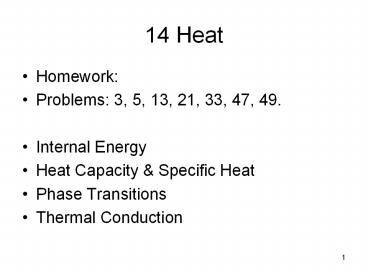14 Heat - PowerPoint PPT Presentation
Title:
14 Heat
Description:
14 Heat Homework: Problems: 3, 5, 13, 21, 33, 47, 49. Internal Energy Heat Capacity & Specific Heat Phase Transitions Thermal Conduction ... – PowerPoint PPT presentation
Number of Views:339
Avg rating:3.0/5.0
Title: 14 Heat
1
14 Heat
- Homework
- Problems 3, 5, 13, 21, 33, 47, 49.
- Internal Energy
- Heat Capacity Specific Heat
- Phase Transitions
- Thermal Conduction
2
Heat
- Heat is energy transferred due to temperature
difference. - Symbol, Q J
- Ex. 4186J heat needed to raise 1kg of water one
degree C.
3
example cs
- in J/(kgC)
- aluminum 920
- copper 390
- ice 2100
- water 4186
4
specific heat
- c Q/mDT J/(kgK)
- heat to raise 1kg by 1 degree C or K.
- slope warming curve DT/Q 1/(mc)
- Q mcDT
5
Calorimetry
- Measure heat lost/gained
6
Example Calorimetry
- 2kg of substance-A heated to 100C. Placed in
5kg of water at 20C. After five minutes the water
temp. is 25C. - heat lost by substance heat gained water.
7
continued
8
Phase Transitions Latent Heat
- L Q/m J/(kg)
- heat needed to melt (f) or vaporize (v) 1kg
9
example Ls
- in J/kg
- melting (f) vaporization (v)
- alcohol 100,000 850,000
- water 333,000 2,226,000
10
Example
- How much heat must be added to 0.5kg of ice at 0C
to melt it? - Q mL (0.5kg)(333,000J/kg)
- 167,000J
- same amount of heat must be removed from 0.5kg
water at 0C to freeze it.
11
Heat Transfer
- Conduction
- Convection
- Radiation
12
Conduction
- Heat conduction is the transmission of heat
through matter. - dense substances are usually better conductors
- most metals are excellent conductors
13
conduction equation
- heat current energy/time watts
- heat current kADT/L
- k thermal conductivity
- DT temperature difference, L below
14
conduction example
- some conductivities in J/(m-s-C)
- silver 429 copper 401 aluminum 240
- Ex Water in aluminum pot. bottom 101C, inside
100C, thickness 3mm, area 280sq.cm. - Q/t kA(Th-Tc)/L
- (240)(0.028)(101-100)/(0.003)
- 2,240 watts heat current
15
Heat transfer
- 2m x 1m window, 4mm thick, single pane glass.
- Assume temp. difference 5C
- Q/t kA(DT)/L (0.84)(2)(5)/0.004
- About 2,000 watts
16
R-Factors and Thermal Resistance
17
Convection
- Convection transfer through bulk motion of a
fluid. - Natural, e.g. warm air rises, cool falls
- Forced, e.g. water-cooled engine
18
Radiation
- Heat transfer by electromagnetic radiation, e.g.
infrared. - Examples
- space heaters with the shiny reflector use
radiation to heat. - If they add a fan, they use both radiation and
convection
19
Summary
- Definition of Internal Energy
- Heat Capacity
- Specific Heat
- Phase Transitions
- Latent Heat
- Phase Diagrams
- Energy Transport by Conduction, Convection, and
Radiation
20
Example
- A student wants to check c for an unknown
substance. She adds 230J of heat to 0.50kg of the
substance. The temperature rises 4.0K.
21
Greenhouse Effect
- dirtier air must be at higher temperature to
radiate out as much as Earth receives - higher temperature air is associated with higher
surface temperatures, thus the term global
warming - very complicated model!
22
Phase Change
- freeze (liquid to solid)
- melt (solid to liquid)
- evaporate (liquid to gas)
- sublime (solid to gas)
- phase changes occur at constant temperature
23
Temperature vs. Heat (ice, water, water vapor)
24
Heat and Phase Change
- Latent Heat of Fusion heat supplied to melt or
the heat removed to freeze - Latent Heat of Vaporization heat supplied to
vaporize or heat removed to liquify.
25
Newtons Law of Cooling
- For a body cooling in a draft (i.e., by forced
convection), the rate of heat loss is
proportional to the difference in temperatures
between the body and its surroundings - rate of heat-loss DT
26
Real Greenhouse
- covering allows sunlight to enter, which warms
the ground and air inside the greenhouse. - the house is mostly enclosed so the warm air
cannot leave, thus keeping the greenhouse warm (a
car in the sun does this very effectively!)
27
Solar Power
- Solar Constant
- Describes the Solar Radiation that falls on an
area above the atmosphere 1.37 kW / m².In
space, solar radiation is practically constant
on earth it varies with the time of day and year
as well as with the latitude and weather. The
maximum value on earth is between 0.8 and 1.0 kW
/ m². - see solarserver.de































